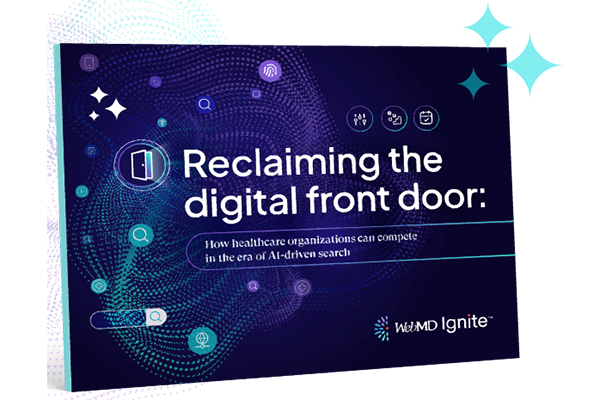Editor's Note: This blog was published prior to the transition to WebMD Ignite.
As the number one leading cause of death in the United States, cardiology is a primary concern for healthcare providers. Unfortunately, cardiology patients rarely take the initiative to resolve potential problems with their heart health until a serious event occurs, such as a heart attack or stroke.
How to increase cardiology leads for your health organization
Healthcare providers can take action by shortening the long lead time for cardiology – most patients have to wait about 44 days from the initial contact to consultation.
With a shorter lead time, patients may see a doctor faster and have more time to manage and resolve heart problems. This also helps providers keep patients in-network.
Thus, growing the cardiology service line can both improve the organization’s bottom line and ensure patients’ continued health.
The problem is – it’s difficult to acquire new patients for cardiology without a smooth operations process to support service line growth. Let’s look at five steps to consider on the path to growing and optimizing this high-value service line.
1. Justify investments and set goals
To expand your organization’s cardiology service line, the first step is to use a Business Planner tool to identify top opportunities and get alignment with the executive team. Understand where the opportunity to grow this service line exists in your market – are there particular “hot spots” of need?
Similarly, it’s important to understand market differences at the sub-service line as well as the procedure level. These insights will support the overall growth plan for cardiology and give you necessary insights to pitch the benefits to the organization’s bottom line and present a clear strategy for growth.
To create alignment with executives and operations, ask why your organization needs more patients. Is it due to decreasing patient volume, new doctors, or even a new facility? In essence, determine why expanding your cardiology service line is a priority.
Once the justification is made, define specific goals. Break each goal down to a granular level, working upwards on the sales funnel. Let’s look at an example:
One organization sets an attainable goal of five new cardiology patients a week. Acquiring patients is the last step in the sales funnel, so they set additional goals working upward in the funnel. To acquire five new patients, the goal is to have eight consultations. To get eight consultations, they need to conduct ten new patient information sessions.
When setting these goals, they should come in two varieties – objectives that are simple to achieve, and objectives that are more difficult to achieve. The simple goal is a realistic, attainable objective that must be met if the program is run properly. The more difficult goal is one that your healthcare organization strives to accomplish. This will ensure the maximum amount of growth without discouraging employees and contributing to burnout.
2. Ensure operational readiness
Verifying operational readiness is a critical step when preparing to acquire new cardiology patients. With a great marketing campaign and poor operations processes, you create demand for competitors. Imagine a potential patient sees your Facebook ad and contacts your access center to schedule an appointment. They are met with busy lines and impatient call center representatives, only to discover the next available consultation is weeks away. They’re likely to call a competitor or give up.
To remedy this, create strong lines of communication between operations, marketing, provider outreach, and the call center. These departments should truthfully evaluate if they are prepared to welcome a significant number of new patients, and work to resolve any shortcomings.
For example, the call center needs to be staffed properly to handle an influx of callers. Agents need to be briefed on campaign messaging and next steps for callers. On the provider side, be sure that the cardiology department has sufficient capacity for new patients. You may need to optimize the routines of doctors or hire more to cope with demand.
With the right preparation, patients entering the funnel are met with a seamless experience from initial contact to their first appointment.
3. Understand your market
To acquire new cardiology patients, you need a strong understanding of the market and, thereby, who your target audience is. Cardiology has many sub-service lines that support it, and it’s critical to understand how these vary in your market.
As mentioned in section one, you should drill into the service line analytics for a better understanding of top opportunities for growth. Through insights from Analytics Solutions from WebMD Ignite, you can define sub-service lines and even procedures that fall under the service line at your hospital.
Propensity modeling in healthcare
Propensity modeling is an analysis of diagnostic, visit history, sociodemographic, socioeconomic, lifestyle, and interest variables to predict the likelihood that someone is a good candidate for cardiology. For example – indicators like comorbidities, BMI, blood pressure, dependency on certain medications, retired/pensioner with an interest in gardening, or a family history of heart conditions all point to a higher propensity for future cardiovascular problems.
Also, consider other market factors like seasonality. For example, March is a common month to schedule screenings since it follows New Year’s resolutions and Heart Month. An understanding of where the market is at from a high-level perspective will help you craft the right messaging.
Take the time to identify the right audience, their preferred communication channels, and craft personalized messaging. A precision marketing campaign deployed at the right time (and through the right channels) is much more likely to garner a response from recipients.
In addition, your campaign will benefit from a deeper understanding of your current cardiology patients. Ask why they chose your practice over another – perhaps your organization offers easy appointment scheduling or particularly knowledgeable doctors. Highlight these insights to your campaign messaging to improve relatability and effectiveness.
4. Execute the campaign & optimize for success
To grow the cardiology service line, take advantage of both traditional and digital marketing. Traditional marketing tactics help to raise awareness about your cardiology service line, but the results are hard to quantify. On top of that, it’s unlikely a direct mailer on its own will turn a consumer into a patient.
Digital marketing is much more effective in acquiring new patients, particularly when integrated as part of a bigger program. As discussed, digital campaigns should be highly segmented and designed to nurture consumers at each step of the education process, guiding them to a point of conversion (like scheduling an appointment, getting a screening, or completing a health risk assessment).
Any properly designed campaign, even an awareness campaign for your cardiology offering, should be curated toward a point of acquisition. Once a campaign begins collecting leads, keep track of where leads are in the acquisition funnel – this helps you optimize the nurturing process. The next step for a consumer who clicked through to your site’s cardiology page vs. a consumer who calls to inquire about cardiology are different.
The acquisition funnel stage should inform which call-to-action you employ — either “soft” or “hard”:
Soft CTAs are better suited to awareness campaigns and are angled towards qualifying leads for cardiology service or learning more about the prospect’s condition and needs.
Hard CTAs are aimed at converting consumers who are ready to take action. An example of a hard CTA would be asking a lead to make an appointment or request a callback from a representative.
Once the campaign is in flight, continually optimize for success. Copy, audiences, CTAs, and imagery can (and should) be tested to improve results and ensure the team is capturing the right leads for cardiology.
5. Measure and share results
After campaign launch, you still need to measure and report on results. Identify key stakeholders (such as the executive team and chairman of cardiology) and open a clear line of communication for sharing campaign insights and successes.
When it comes time to share results (and showcase measurable growth to the cardiology service line), take advantage of both leading and lagging indicators:
- Leading indicators are performance results that are available and visible almost immediately and can be used to predict the future of the campaign. Some examples of leading indicators are conversion rate, ad metrics, user experiences, and lead metrics. This is valuable to measure and report on while the campaign is in flight. Conversion rate is one of the most important leading indicators to measure. Did you know even a 1 percent change in conversion rate has an exponential impact on ROI? Here are four main factors that go into conversion rate:
- Highly Qualified Leads: Finding highly qualified leads requires a well-maintained marketing strategy, as outlined previously. When this strategy is executed and optimized properly, your organization will spend precious time and effort on leads most likely to convert to patients.
- Operational Readiness: Make sure that your organization has processes to direct potential patients through the funnel. Who is answering the phone, and are they taking appropriate measures to bring the lead to convert? After that point, what is the follow-up process?
- Clinical Capacity: Unfortunately, 1 in 6 healthcare campaigns have been stopped prematurely due to an unforeseen lack of capacity. Ensure your organization can support the targeted number of patients before embarking on the campaign. Otherwise, you will experience patient attrition that creates demand for competitors.
- Geographical Factors: Keep location in mind. For example, target areas with a high number of sedentary individuals, or a regional cuisine that can have a negative effect on heart health.
- Lagging indicators are more holistic results that directly translate to campaign success. These include operational metrics such as patient volume, no shows, increased revenue, or improved ROI. Unfortunately, these valuable lagging indicators are not available until after the campaign is complete.
- Net patient revenue, total investment, and ROI are three critical post-campaign metrics to measure. Here’s how to calculate them:
- Net patient revenue should come from your finance team. However, if you are trying to estimate we suggest using this formula:(Average revenue per encounter) x (average number of encounters) x (new patients)
- Total investment is the amount spent on the campaign: (Cost per lead) x (leads generated)
- ROI can be calculated using net patient revenue or contribution margin, discuss with your finance team to ensure you’re measuring ROI the same way the rest of the organization does. Regardless of if you use revenue or margin, the formula is the same: (Net patient revenue – total investment) / total investment
To communicate this information as clearly as possible, create an executive dashboard, which emphasizes key metrics and data visualizations. This way, key stakeholders can easily review and understand the impact the campaign had on growing the cardiology service line and the organization’s bottom line.
Final thoughts
When seeking to expand your cardiology service line, do not overlook the key role of operations when planning and optimizing campaign results. Be aware that optimizing is a constant process, and campaign information, from successes to failures, should be organized and communicated on a regular basis to create the best results possible.
The bottom line is, cardiology is a life-saving discipline. With the right campaign and strategy in place, the marketing team can encourage patients to manage their heart conditions earlier and improve long-term heart health.





